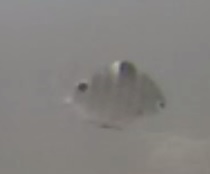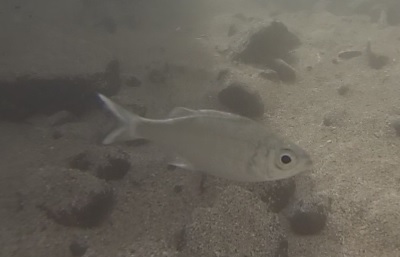Final grades for the semester were due on Christmas Eve the 24th, and I had students calling me on my office phone and emailing me to ask about their grades up until the last minute on the afternoon of the 24th. Then I was looking forward to a much needed break and went fishing with a video camera. I'll try adding one of the videos here. It is down-sampled a bit to reduce the file size online. This is a video of a Mokuleia tidepool on O'ahu.
You can clearly see three (?) fish species. I am not a marine biologist (this is also part of a personal project on my part to learn more about marine natural history here in Hawai'i), so be suspicious of my attempts at identification. I am fairly certain that two of the species are sharnosed mullets (Neomyxus leuciscus, uouoa in Hawaiian)--the larger long ones--and (juvenile)
blackspot sergeants (Abudefduf sordidus, Kūpīpī)--the ones with false "eye spots".
I suspect that flagtails are also present (Kuhlia spp., ʻāholehole) and the most common in this video, but I am less confident about their identification (see the update below, these are actually reticulated flagtails, Kuhlia sandvicensis). There are also two brief glimpses of a third species that I suspect is a "rockskipper" zebra blenny.
If this works well then I will try uploading some more videos.
-----
I sent a picture of the flagtail from the video to some of my coworkers to ask about its identification.
Dr. Kathleen Cole wrote this in reply:
Hi Floyd.
This looks more like the reticulated flagtail, Kuhlia sandvicensis (also referred to as aholehole). It has a broader distribution than K. xenura, the latter of which is an endemic. Distinguishing features include a pale gray rather than dark grey tail, sometimes with a pale margin (which shows up in your picture), and a flattish, rather than slightly concave, head profile. The eye tends to be smaller in sandvicensis, but that doesn't help much unless you have the two species side by side.
Juveniles of both species are found in shallow coastal waters and tide pools so are easy to encounter.
Kassi
I also came across an article about the flagtails in Hawai'i that discusses some of the difficulties and confusion in distinguishing between them.


